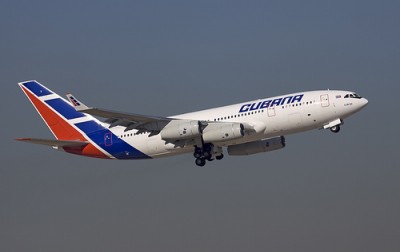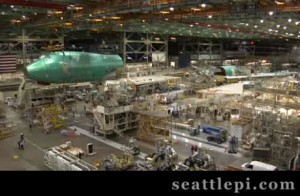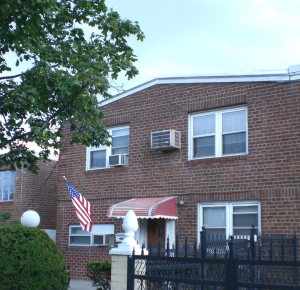
View of a crashpad in New York
A lot of people in the in the business will know what a “crashpad” is, but most on the outside might have no idea. If you envision flight attendants and pilots travelling around the world staying at the best hotels, you would might be surprised to learn that most of the time they are staying at a crashpad.
So what is an airline crashpad? As it might sound, it is a place where airline employees can stay cheaply. A lot of crew do not live where they are based. For example, in this interview, Shelby lives in Texas, but it based out of New York. This means she must make the commute from DFW to LGA and have a cheap place to “crash” while waiting for her next flight. Depending on the type of crashpad, people can have their own bed and space. Others share a bed and having almost no private space.
To learn more, I interviewed Shelby (be sure to check out her blog), who works for a major US airlines. She has been working as a flight attendant since 2001. Here is our interview:
AirlineReporter: Who stays at crashpads?
Shelby:Our Crashpad is not only shared by pilots from all airlines, flight attendants from all airlines, but also with air marshals,& maintenance folks that have been displaced by their airlines. Thank goodness we are NOT all here at the same time!
AR: How big is your crashpad?
S:My crashpad has 6 Bedrooms & four bathrooms for approximately 25 people. I’m lucky, in the “Girls Room” (we call

Picture of the laptops. "Seriously, we can't live without them"
it the “Presidential Suite”) there are only two of us & we have our own bathroom. I share with a First Officer. She and I both work for the same airline, which is nice, we speak the same airline language. We are rarely here at the same time, which means 90% of the time, I have the place to myself.
AR: Do you have to pay to use them?
S:Oh yes, you have to pay, the “Owners” of the crashpads actually prefer it! I pay $250.00 for my crashpad and this is considered a high amount to most folks I speak to. For this price I get, my own bed, Wi-Fi, Cable, maid service, and use of all the common areas (living room, kitchen, deck, back yard & grill)
AR: Do you like your crashpad?
S:I like my CrashPad, I am within walking distance to LGA,;it takes approximately 11 minutes from my front door to my airline operations. There are way better neighborhoods for crashpads here in New York, like Kew Gardens, which is pretty much like crew crashpad headquarters; it’s half way between LGA & JFK and a preferred area, however this means every time you fly in or out, it is a bus or taxi ride.
AR: For example, how much will you be at your crashpad this month?
S:This month I fly LGA to MIA for 3 days straight returning to the crashpad every night, so for August, I will stay in my crashpad 12 days. It is nice to know, when I return I know that my bed will be waiting for me!
AR: Are there any short-term type crashpads?
S: Yes, they are called ’œhot beds’, meaning, they are 1st come 1st serve. They can run anywhere from $20.00 per night to $175.00 per month! When they arrive they have to find a bed, make up their bed, and crawl in, all the while trying not to wake up the others sleeping around them. This is one reason I pay more. After a long day, I like knowing that I have my bed, with my sheets, in my room to crawl into.
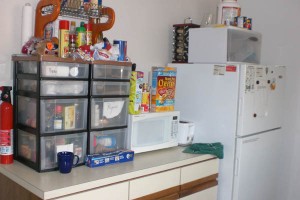
The nicely kept shared kitchen needs to stay clean!
AR: Which was your favorite crashpad?
S: When I was based in Chicago, we stayed at the DoubleTree Suites. We had seven flight attendants that shared one suite! The hotel had a nice Gym, Pool, Happy Hour, Free Breakfast ’¦oh and the Double Tree COOKIES!!! (which is why we needed the gym).
AR: Which was your least favorite?
S: Was when I was a new hire, all the classmates that I graduated with piled into a cheap nasty hotel… 10 of us 2 beds. ’œ Are you Serious??’ I stayed 4 hours & left!
AR: With all those people sharing a shower, how do you work it out?
S:Since I’m lucky now & only share with one, it is not an issue. Most crash pads have signup sheets for “Shower Time”, based on what time you fly the next day. Trust me, you know your fellow crashpad
buddies. You do a lot of things in the dark & a lot of tip-toeing is going on in the wee hours of the morning.
Some other questions that some fine followers of Shelby on Twitter asked:
Who does the dishes?
If you want to make your fellow crashpaders angry, don’t clean up after yourself. You will be asked to leave ASAP! You do your own dishes!!
Who washes your sheets?
Well, If you stay at a hotel crashpad, they are usually done for you. If you live in a single family home, hopefully the owner of the crashpad has a washer & dryer and they let you use it. We don’t have
one here at our crashpad. Thank goodness we have lots of Laundromats, in our neighborhood.
Who puts the CrashPads together?
My CrashPad is run by a New York Cop! A lot of pilots & flight attendants run their own crashpads, I believe, out of years of frustration! There is this one crashpad here in New York that is affectionately called the “Sticky-Note” crashpad, because the owner is constantly putting up Sticky Notes on what NOT to do, I mean they are everywhere!
Thank you Shelby for the interview and if any of you have any additional questions, let me know and I will ask her!
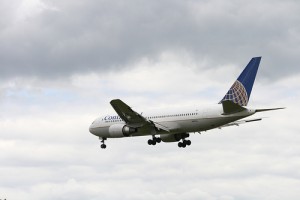
Continental Boeing 767-200 much like the one involved in this incident.
Continental airlines flight 128 from Brazil to Texas hit a bad patch of turbulence, injuring over 30 passengers. The Boeing 767 was about six hours into its flight when all of a sudden the aircraft lost altitude. Passenger Fabio Ottolini stated, “People didn’t have time to do anything.” He stated that flight attendants were in the middle of service when the incident occurred, causing some to hit the ceiling. The aircraft landed in Miami where 13 people were taken to local hospitals and four were seriously injured.
This is reminder that everyone should keep their seatbelts on while in flight. Yes, it is very tempting to take the belt off, but it is never worth the risk. The Science Christian Monitor reports that from 1980 to June 2004, airlines in the United States had 198 turbulence accidents, resulting in 266 serious injuries and three fatalities. The three fatalities resulted in passengers not wearing their seatbelt, while the fasten seatbelt sign was illuminated.
For updates on this story, check out Ben Mutzabaugh’s blog, Today in the Sky.
Image: sohvimus
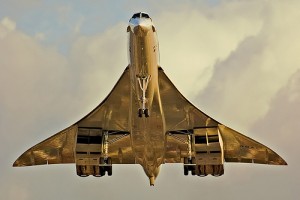
British Airways Concorde landing at Heathrow in 2003.
When the TU-144 and Concorde first went into service in the 1970’s , it was a time of aviation excitement. Both aircraft had the promise to completely revolutionize commercial transportation, providing speeds over twice the speed of sound (around 1100 mph vs 500-600 mph for other commercial airliners). Most thought the supersonic transport (SST) would replace other aircraft, to become the norm in general aviation. It was thought the sonic boom experienced when a jet goes over the sound barrier would become part of daily life, and people would be willing to live with them to have fast transportation.
The Tupolev TU-144 was the first SST to take flight in December 1968, two months before the Concorde. The TU-144 hit a big setback when the first production aircraft crashed during the 1973 Paris Air Show, killing all six crew members aboard and 15 people on the ground. Then in 1978 another TU-144 crashed during a pre-delivery test flight, killing all aboard. The aircraft type flew 55 passenger flights with Aeroflot before it was pulled from service in June of 1978, less than ten years after its first flight.
At the time Boeing was also working on their own SST, the Boeing 2707. The US didn’t want Europe and Russia to have the monopoly on SST technology, so the US government funded a contract for Boeing to study making its own. In 1963 the National Supersonic Transport program subsidized 75% of development costs to help Boeing directly compete with the TU-144 and Concorde. Since the Concorde and TU-144 were almost twins, Boeing wanted to make something different and were aiming to make a 250 passenger SST, which would hold about twice the passengers of the other two. In March 1971, funding for the project was canned by Congress and although private funding was able to raise nearly $1 million, the entire project was shut down in May of 1971. At the time, the Boeing 2707 had 115 orders from 25 airlines and the Concorde only had 74 order from 16 customers.
The Concorde and Tu-144 might have looked similar, but Arospatiale-BAC’s Concorde was superior in its avionics and capabilities. It has its first flight in March of 1969 and entered service in 1976. During that time, the first two prototypes traveled the world to build excitement and there were 70 orders for the plane. However, many orders were canceled after an oil crisis caused financial difficulty for the airlines, the crash of the similar TU-144, and concerns about the sonic-boom not being acceptable in populated areas. In the end, only British Airways and Air France took delivery of the Concorde. The plane was flown until 2003 when Air France flight 4590 crashed in France killing all 109 people aboard and raising questions about the safety of the aircraft. The aircraft was retired on November 26, 2003.
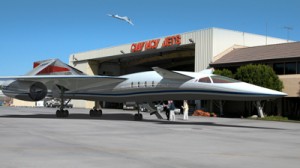
Supersonic Aerospace International's QSST rendering.
There was hope in the early 90’s for a resurgence of SST when a wealthy businesswoman, Judith DePaul, worked with Tupolev and NASA to use a TU-144 as a testbed for additional SST research. Over $350 million was spent on retrofitting the mothballed Tu-144 and it made a total of 27 flights through the 90’s, but was canceled in 1999 for “lack of funding.” Today, the aircraft is rusting away in storage with little hope of being used again.
It has been over 40 years since the first SST flight occurred and almost 6 years since the last SST commercial flight. It has seemed unlikely there will be a revival of the Concorde or TU-144, but there might be hope on the horizon. The biggest hurdle has been the sonic-boom heard when an aircraft passes the sound barrier. The loud and disruptive boom caused previous SST’s to be flown only over water. Scientists are currently working on ways to “shape” the boom, making it sound more like distant thunder, something that the general public could live with to allow flights over land.
Even if the technology becomes available, it is not going to be cheap. A round trip ticket from New York to London on the Concorde before its cancellation ran about $10,000.00 USD. However, history has shown new technology can be expensive at first but as it develops can become more cost effective. The Concorde didn’t have time to become less costly since the technology became stagnant.
It would be a long while before Boeing or Airbus would start seriously considering making a SST line of aircraft. But smaller business jet companies are spending good sums of money researching new technology that is being dubbed Quiet Supersonic Transport (QSST). Supersonic Aerospace International is working on creating the next generation of SST starting in the business jet realm. They are hoping to have their first aircraft flying by 2014 with first customer delivery in 2016. Even if they wouldn’t be able to make those optimistic goals, it seems like there would be a big market for business people being able to save time while in-flight around the world.
Who knows where the future will go for SST? Will the start of space travel help in the development in the next SST? I would think there might be some overlap. There are those that already talk about post-SST and moving to hypersonic flight , but that is going to be far out in the future. It seems it might be most beneficial for the technology to start on a smaller scale. It looks like smaller companies might create SST business jets and allow the wealthy to help pay for the development of the technology. As the technology grows, becomes more accepted and less costly, larger aircraft manufacturers could pick up the production of SST aircraft and usage would spread.
Images:
Concorde (Spencer Wilmot)
QSST (SAI)




